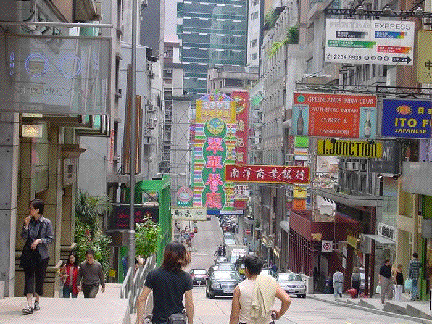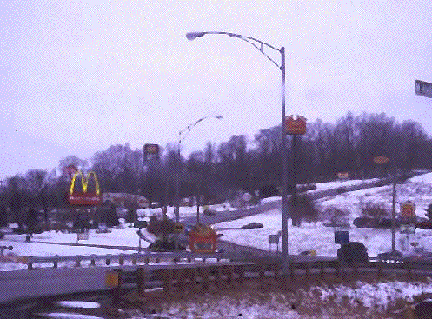Let’s Dream of a Better World
February 25, 2006
I was thinking about writing about the relationship of debt creation and inflation, or Bernanke’s “sacrifice ratio” concept — and come to think of it I still haven’t written about the amazing summer of 1972 — but instead I thought I’d talk about some of my other interests, particularly what is sometimes known as “urban geography.”
It has become clearer to me, over the years, that the post-World War II industrial lifestyle experiment, led and exemplified by the United States, is a gross failure and tragedy. In the longer sweep of history it will be seen as a brief phase, somewhat like Communism in China (i.e. a command economy under a Maoist dictator, unlike the capitalist economy under a mandarinate government of today) will be seen as a brief episode in Chinese history. The most basic reason why it won’t continue is that it can’t: it is too consumptive of resources and destructive of the environment. But even if that could be mitigated somehow, for example by some as-yet-unknown energy source to replace fossil fuels, it is so unpleasant that people will eventually decide to put it out of its misery one way or another.
This “post World War II industrial lifestyle experiment” has a multitude of aspects. To start with, let’s list some of the nicer qualities, perhaps things that we want to keep as part of our New Way of Living which will replace the PWW2ILE. Here’s a brief list:
1) good plumbing, which has helped greatly with
2) cleaner cities, and thus:
3) a major reduction in infectious disease.
4) Electricity, which allows:
5) air-conditioned offices. OK, I could live without this, and I have never used an air conditioner at home even when I’ve owned one, but this seems to me like one luxury that is worth keeping.
This list is nearly exhaustive, meaning that I would be hard pressed to think of a #6, let alone a #10. Think of that: all of our meaningful advances can be reduced to an index card, and by the way they were all accomplished by 1970.
I have personally experienced both rural living (in Vermont) and urban living (in Tokyo and San Francisco), and both are fine with me. The problem lies with suburban living, the sort of living arrangement that appeared on the scene after World War II. This was something completely different, made possible by widespread automobile usage. If you go back in human history, as far back as you like, you find both urban and rural living. People have lived in large cities since Sumerian times, around 3500 BC. Today, in the United States, there aren’t many people living in true urban environments (defined as a place where it is easier to not own a car than to own one), nor are there many people living in traditional rural situations, which historically has meant independent farms. “Rural” areas today tend to be the outer scatterings of the suburbs, or just plain depopulated places.
I won’t go on too long about the problems of the suburbs, especially as Jim Kunstler (www.kunstler.com) has done such a good job of it. But let’s think of what our living arrangement of the future, replacing the present tragedy, may entail. First, it should be both more urban, and more rural. More urban as city dwellers dwell in urban (no car) environments, and more rural as, perhaps, more people also live on largely self-sufficient farms. I don’t know quite how the move to more individual farmers might come about, but it may be a part of a process by which we abandon today’s artificial agriculture and re-embrace real food, natural non-hybridized varieties grown without artificial fertilizers, herbicides, or pesticides. Indeed, “organic” meats and vegetables have been a big winner in the otherwise stable agricultural sector, growing by about 20% per year in recent years, and much of this is produced by smaller operators. Is this an advancement? In 1930, all food was “organic.” Perhaps we could adopt the Japanese solution of simply making corporate farming illegal. The result of that policy has been somewhat higher food prices, but so what — Japanese are wealthy people and they can afford it. The food quality is much better than what we have in the US, and a tradition of independent farmers is maintained. There has been quite a bit of talk recently that depleting fossil fuel supplies will lead to the readoption of farming in historic farming districts like Pennsylvania, Western Massachussets and New York State, which are now largely unused.
Urban (no car) environments have traditionally been ones where the preferred method of transportation is walking, as in London or Paris of 1830 for example, but since this is a bit impractical today, we should expect to use trains. Trains are wonderful, highly evolved technology, and there isn’t much that one could do to make them better. Nor are there many alternatives, except for variants such as aboveground monorails instead of below-ground subways. Trains will be the preferred transportation system of the future, unless we get ourselves in such a mess that we end up walking. However, trains and cities are built together — the city must be built for trains, which in practice means that once you step off the train, you are in an environment where you can walk instead of taking a car. You cannot plop trains down in a city built for cars and expect them to work. When you get off the train, all you find is a giant parking lot. So we are facing the rebuilding of all our urban areas, a rather daunting prospect although hardly an insurmountable one. The fact is, most of our urban areas have been built in the last fifty years anyway, so in a sense we would just be doing what we have been doing. The Chinese have been rebuilding their urban environment at a much faster pace than that.
I am writing this in part because I think of the Chinese, who, understandably, have visions of living a “western” i.e. US-style lifestyle in the future. They will fail, as they will find it physically impossible to do so, but even before then I would like to warn the Chinese and others that imitating the US is not even desirable, as it is a failure and a tragedy. Chinese people would be better off imitating Hong Kong, which is much closer to what I have in mind, as Hong Kong is both a hyper-dense city of six million inhabitants and a place where nature is close at hand and relatively unmolested. You can actually put your boots on in the middle of the financial district in Hong Kong and go for a nice hike in the mountains of Hong Kong Island. So, for China: lots of trains, tall buildings, narrow roads, no parking, and stop building expressways. (It’s best to be specific and not too philosophical.)

More like this. (Hong Kong)
Narrow streets, tall buildings, people walking around, no parking, trains

Less like this. (Las Vegas)

Crap like this as far as the eye can see. (Some nameless suburban hellhole.)

Is there anything more dismal in the 5500-year history of cities?
China is already running into problems with water supply. Humans are grossly wasteful of water, and not because you leave the faucet on when you brush your teeth. The average US citizen uses roughly 70 gallons of water a day. Much is flushed down the toilet, due to the somewhat bizarre practice of pooping in drinking water. Even more is used for taking care of the bits and pieces of suburbia, such as watering lawns and washing cars, especially in arid environments like Los Angeles or Phoenix, where people have the psychotic need to maintain lawns reminiscent of the English countryside. In my better future, human waste would be composted, which is what the Chinese did with their “night soil” for thousands of years, before adopting the recent habit of pooping in drinking water. Nevertheless, it must be said that the modern flush toilet contributes greatly to general urban cleanliness. Fortunately, today we actually have flush toilets (they use about a pint of water, and there are no-water toilets as well) that are connected to a central composter, which could be kept in the basement of an apartment building for example.

Sun-Mar commercial composting system
www.sun-mar.com
As for electricity, we should eventually be using much less of it, which would allow a far greater portion of total electricity generation to be accomplished by “renewable” methods. If 25% of electricity today comes from hydroelectric, solar, wind, etc. (it’s not 25% but let’s imagine), then if people used 75% less electricity in total, then 100% of electricity could be supplied from renewable resources. This inevitably conjures up images of huddling around a kerosene lamp, but in fact it is not very hard at all to reduce electricity usage dramatically while maintaining a fully modern lifestyle. Anyone who investigates “getting off the grid” with some backyard solar/microhydro/wind project inevitably finds that it is far easier to use less electricity than to generate more. A 100W incandescent light bulb uses 100W of electricity. That’s a lot. A compact fluorescent bulb that produces the same amount of light uses 25W. And a hyper-bright LED bulb that can produce the same amount of light in a small area (but not in all directions) uses about 4W. 100W to 4W, just by changing lightbulbs. Then, of course, if you have a smaller domicile (like those in Hong Kong instead of those in Alexandria, Virginia), you might have three or four light bulbs in a room instead of ten or fifteen. Of course, it’s easy to turn off the air conditioner, which is not at all needed in residential environments even in the hottest weather, if the building has been properly designed. An electric fan uses about 5% of the power. Today’s superefficient refrigerators use about 20% of the power of the regular ones, but keep food just as cold. Higher electricity prices (MUCH higher) would bring all this about. How about this: put a $0.15/kwh tax on electricity (mine costs about $0.13 now so this would be a doubling), and eliminate taxes on something else, like capital gains? Or maybe use the proceeds from higher taxes on energy/water to fund a national health system.
There is a lot to think about here, so we will revisit it from time to time.

